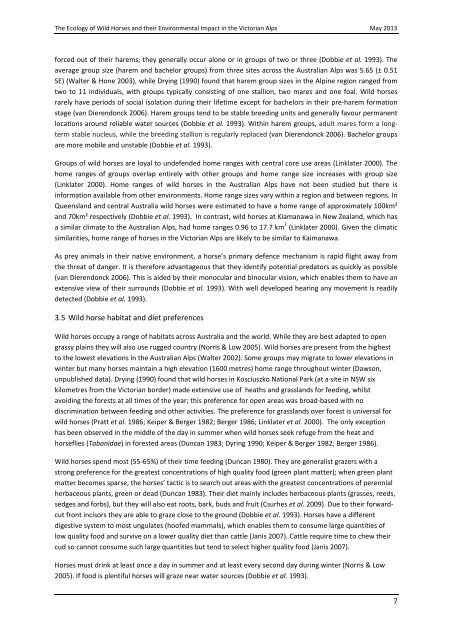The Ecology of Wild Horses and their Environmental ... - Parks Victoria
The Ecology of Wild Horses and their Environmental ... - Parks Victoria
The Ecology of Wild Horses and their Environmental ... - Parks Victoria
You also want an ePaper? Increase the reach of your titles
YUMPU automatically turns print PDFs into web optimized ePapers that Google loves.
<strong>The</strong> <strong>Ecology</strong> <strong>of</strong> <strong>Wild</strong> <strong>Horses</strong> <strong>and</strong> <strong>their</strong> <strong>Environmental</strong> Impact in the <strong>Victoria</strong>n Alps May 2013forced out <strong>of</strong> <strong>their</strong> harems; they generally occur alone or in groups <strong>of</strong> two or three (Dobbie et al. 1993). <strong>The</strong>average group size (harem <strong>and</strong> bachelor groups) from three sites across the Australian Alps was 5.65 (± 0.51SE) (Walter & Hone 2003), while Drying (1990) found that harem group sizes in the Alpine region ranged fromtwo to 11 individuals, with groups typically consisting <strong>of</strong> one stallion, two mares <strong>and</strong> one foal. <strong>Wild</strong> horsesrarely have periods <strong>of</strong> social isolation during <strong>their</strong> lifetime except for bachelors in <strong>their</strong> pre-harem formationstage (van Dierendonck 2006). Harem groups tend to be stable breeding units <strong>and</strong> generally favour permanentlocations around reliable water sources (Dobbie et al. 1993). Within harem groups, adult mares form a longtermstable nucleus, while the breeding stallion is regularly replaced (van Dierendonck 2006). Bachelor groupsare more mobile <strong>and</strong> unstable (Dobbie et al. 1993).Groups <strong>of</strong> wild horses are loyal to undefended home ranges with central core use areas (Linklater 2000). <strong>The</strong>home ranges <strong>of</strong> groups overlap entirely with other groups <strong>and</strong> home range size increases with group size(Linklater 2000). Home ranges <strong>of</strong> wild horses in the Australian Alps have not been studied but there isinformation available from other environments. Home range sizes vary within a region <strong>and</strong> between regions. InQueensl<strong>and</strong> <strong>and</strong> central Australia wild horses were estimated to have a home range <strong>of</strong> approximately 100km²<strong>and</strong> 70km² respectively (Dobbie et al. 1993). In contrast, wild horses at Kiamanawa in New Zeal<strong>and</strong>, which hasa similar climate to the Australian Alps, had home ranges 0.96 to 17.7 km 2 (Linklater 2000). Given the climaticsimilarities, home range <strong>of</strong> horses in the <strong>Victoria</strong>n Alps are likely to be similar to Kaimanawa.As prey animals in <strong>their</strong> native environment, a horse’s primary defence mechanism is rapid flight away fromthe threat <strong>of</strong> danger. It is therefore advantageous that they identify potential predators as quickly as possible(van Dierendonck 2006). This is aided by <strong>their</strong> monocular <strong>and</strong> binocular vision, which enables them to have anextensive view <strong>of</strong> <strong>their</strong> surrounds (Dobbie et al. 1993). With well developed hearing any movement is readilydetected (Dobbie et al. 1993).3.5 <strong>Wild</strong> horse habitat <strong>and</strong> diet preferences<strong>Wild</strong> horses occupy a range <strong>of</strong> habitats across Australia <strong>and</strong> the world. While they are best adapted to opengrassy plains they will also use rugged country (Norris & Low 2005). <strong>Wild</strong> horses are present from the highestto the lowest elevations in the Australian Alps (Walter 2002). Some groups may migrate to lower elevations inwinter but many horses maintain a high elevation (1600 metres) home range throughout winter (Dawson,unpublished data). Drying (1990) found that wild horses in Kosciuszko National Park (at a site in NSW sixkilometres from the <strong>Victoria</strong>n border) made extensive use <strong>of</strong> heaths <strong>and</strong> grassl<strong>and</strong>s for feeding, whilstavoiding the forests at all times <strong>of</strong> the year; this preference for open areas was broad-based with nodiscrimination between feeding <strong>and</strong> other activities. <strong>The</strong> preference for grassl<strong>and</strong>s over forest is universal forwild horses (Pratt et al. 1986; Keiper & Berger 1982; Berger 1986; Linklater et al. 2000). <strong>The</strong> only exceptionhas been observed in the middle <strong>of</strong> the day in summer when wild horses seek refuge from the heat <strong>and</strong>horseflies (Tabanidae) in forested areas (Duncan 1983; Dyring 1990; Keiper & Berger 1982; Berger 1986).<strong>Wild</strong> horses spend most (55-65%) <strong>of</strong> <strong>their</strong> time feeding (Duncan 1980). <strong>The</strong>y are generalist grazers with astrong preference for the greatest concentrations <strong>of</strong> high quality food (green plant matter); when green plantmatter becomes sparse, the horses’ tactic is to search out areas with the greatest concentrations <strong>of</strong> perennialherbaceous plants, green or dead (Duncan 1983). <strong>The</strong>ir diet mainly includes herbaceous plants (grasses, reeds,sedges <strong>and</strong> forbs), but they will also eat roots, bark, buds <strong>and</strong> fruit (Csurhes et al. 2009). Due to <strong>their</strong> forwardcutfront incisors they are able to graze close to the ground (Dobbie et al. 1993). <strong>Horses</strong> have a differentdigestive system to most ungulates (ho<strong>of</strong>ed mammals), which enables them to consume large quantities <strong>of</strong>low quality food <strong>and</strong> survive on a lower quality diet than cattle (Janis 2007). Cattle require time to chew <strong>their</strong>cud so cannot consume such large quantities but tend to select higher quality food (Janis 2007).<strong>Horses</strong> must drink at least once a day in summer <strong>and</strong> at least every second day during winter (Norris & Low2005). If food is plentiful horses will graze near water sources (Dobbie et al. 1993).7
















